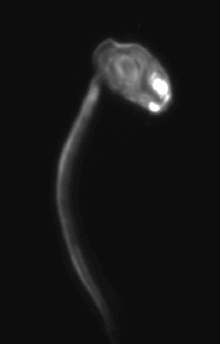Larvacea
Larvaceans (Class Appendicularia) are solitary, free-swimming tunicates found throughout the world's oceans. Like most tunicates, appendicularians are filter feeders. Unlike most other tunicates, they live in the pelagic zone, specifically in the upper sunlit portion of the ocean, or sometimes deeper. They are transparent planktonic animals, generally less than 1 cm (0.39 in) in body length, excluding the tail.
| Appendicularia | |
|---|---|
 | |
| Oikopleura dioica | |
| Scientific classification | |
| Kingdom: | |
| Phylum: | |
| Subphylum: | |
| Class: | Appendicularia Lahille 1890 |
| Order: | Copelata |
| Families | |
| |
| Synonyms | |
|
Larvacea Herdman 1891 | |
Body shape
The appendicularian body shape resembles that of the tadpole-like larvae of most tunicates. Like a common tunicate larva, the adult appendicularian form has a discrete trunk and tail.
Appendicularians produce a test – a kind of skeleton of protein and cellulose – called a "house". In most species, the house surrounds the animal like a bubble. Even for species in which the house does not completely surround the body, such as Fritillaria, the house is always present and attached to at least one surface.
These houses are discarded and replaced regularly as the animal grows in size and its filters become clogged; in Oikopleura, a house is kept for no more than four hours before being replaced. No other tunicate is able to abandon its test in this fashion. Discarded larvacean houses account for a significant fraction of organic material descending to the ocean depths.[1]
The tail of appendicularians contains a central notochord, a dorsal nerve cord, and a series of striated muscle bands enveloped either by epithelial tissue (oikopleurids) or by an acellular basement membrane (fritillarids). Unlike the Ascidiacea larvae, the tail nerve cord in appendicularians contains some neurons.[2]
Feeding
Appendicularians have greatly improved the efficiency of food intake by producing a test, which contains a complicated arrangement of filters that allow food in the surrounding water to be brought in and concentrated prior to feeding. By regularly beating the tail, the appendicularian can generate water currents within its house that allow the concentration of food. The high efficiency of this method allows larvaceans to feed on much smaller nanoplankton than most other filter feeders.
Like most tunicates, appendicularians feed by drawing particulate food matter into their pharyngobranchial region, where food particles are trapped on a mucus mesh produced by the pharynx and drawn into the digestive tract. The mucus mesh lies over two clefts in the pharynx, one on either side, rather than the much larger number of clefts found in most other tunicates.
Furthermore, the Larvacea retain the ancestral Chordate characteristics of having the clefts, and the anus open directly to the outside, and by the lack of the atrium and the atrial siphon found in related classes.
Reproduction and genetics
Appendicularians reproduce sexually. The immature animals resemble the tadpole larvae of ascidians, albeit with the addition of developing viscera. Once the trunk is fully developed, the larva undergoes "tail shift", in which the tail moves from a rearward position to a ventral orientation and twists 90° relative to the trunk. Following tail shift, the appendicularian begins secretion of the first house.
The recent development of techniques for expressing foreign genes in Oikopleura dioica has led to the advancement of this species as a model organism for the study of gene regulation, chordate evolution, and development.
Footnotes
References
- Robison, B.H.; Reisenbichler, K.R.; Sherlock, R.E. (2005). "Giant larvacean houses: Rapid carbon transport to the deep sea floor". Science. 308 (5758): 1609–1611. doi:10.1126/science.1109104. PMID 15947183.
- Kaas, Jon H. (2016). Evolution of nervous systems. Elsevier Science. pp. 14ff. ISBN 978-0-12-804096-6.
- Bone, Q. (1998). The Biology of Pelagic Tunicates. Oxford, UK: Oxford University Press.
- Clarke, T.; Bouquet, JM; Fu, X; Kallesøe, T.; Schmid, M; Thompson, E.M. (2007). "Rapidly evolving lamins in a chordate, Oikopleura dioica, with unusual nuclear architecture". Gene. 396 (1): 159–169. doi:10.1016/j.gene.2007.03.006. PMID 17449201.
| Wikispecies has information related to Larvacea |